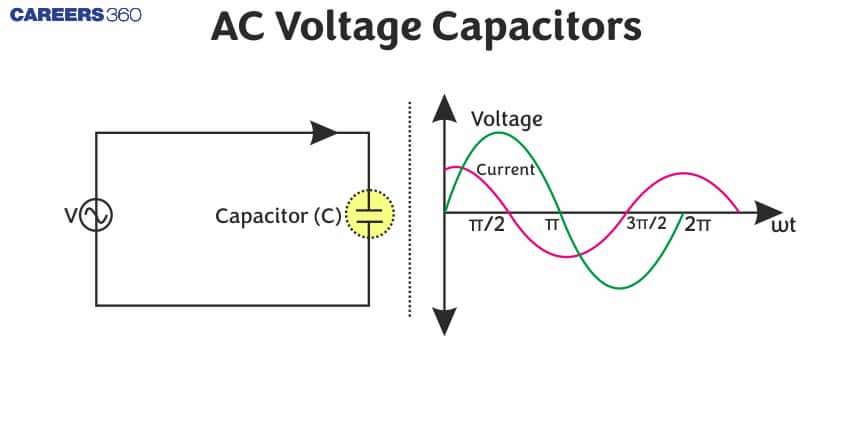AC Voltage Capacitors
Capacitors are available in various shapes and sizes. Capacitor consists of two conducting plates which are separated by a dielectric material. This dielectric material is the insulating material which opposes the flow of current. The basic function of any capacitor is to store electrical energy and the ability of the capacitor to store the charge is known as capacitance. Capacitors store energy directly onto the conducting plates which makes the process of charging or discharging much faster. Capacitors allow the AC(Alternating current) to pass but to avoid a hazardous breakdown of the circuit, they block the flow of DC(Direct current).
This Story also Contains
- Importance Of Capacitors
- AC Through Purely Capacitive Circuit
- Power In A Purely Capacitive Circuit
- Applications Of Capacitors

Importance Of Capacitors
Capacitors are effective in filtering out unwanted frequencies and they can handle power loss efficiently and make power production more economical. Capacitors are important components as they are less sensitive to temperature and they discharge current almost instantaneously. They are capable of handling high voltage applications also.
AC Through Purely Capacitive Circuit
A circuit which contains only a pure capacitor of capacitance connected across an alternating voltage source is called a purely capacitive circuit. An alternating current or AC generator is generally used as an AC voltage source.
Applied alternating voltage to the circuit is given by
V=V_{m}sin\omega t ![]() … … …(i)
… … …(i)
At any instant of time, the charge of the capacitor is q=CV
The instantaneous potential drop \frac{q}{C}  across the capacitor should be equal to the alternating voltage which is applied to the circuit because there is no resistance in the circuit.
across the capacitor should be equal to the alternating voltage which is applied to the circuit because there is no resistance in the circuit.
So, we can write, \frac{q}{C}=V_{m}sin\omega t  … … … (ii)
… … … (ii)
The instantaneous value of current flowing through the circuit at time ‘t’ is given by i=\frac{dq}{dt} 
Substituting the value of ‘q’ from equation (ii), we will get,
i=\frac{d}{dt}CV_{m}sin\omega t ![]()
So, i=\omega CV_{m}cos\omega t ![]()
We can write the above equation as
i=\omega CV_{m}sin\left ( \omega t+\frac{\pi }{2} \right )

=\frac{V_{m}}{\left ( \frac{1}{\omega C} \right )}sin\left ( \omega t+\frac{\pi }{2} \right )
 As we know, X_{C}=\frac{1}{\omega C}
As we know, X_{C}=\frac{1}{\omega C}  which is the opposition offered to the flow of alternating sinusoidal current by a pure capacitor which is known as capacitive reactance.
which is the opposition offered to the flow of alternating sinusoidal current by a pure capacitor which is known as capacitive reactance.
Therefore, i=\frac{V_{m}}{X_{C}}sin\left ( \omega t+\frac{\pi }{2} \right )
 … … …(iii)
… … …(iii)
The value of current will be maximum when sin\left ( \omega t+\frac{\pi }{2} \right )
 becomes equal to 1.
becomes equal to 1.
So, i_{m}=\frac{V_{m}}{X_{c}} 
Substituting the value of \frac{V_{m}}{X_{c}}  in equation (iii), we will get,
in equation (iii), we will get,
i=i_{m}sin\left ( \omega t+\frac{\pi }{2} \right ) 
From this equation, we can say that the current is purely sinusoidal and leads voltage by 90 degrees.
This phase relationship is shown in the figure given below.
Power In A Purely Capacitive Circuit
Instantaneous power supplied to the capacitor can be obtained by taking the product of instantaneous voltage and current.
P=Vi=\left ( V_{m}sin\omega t \right )\left ( i_{m}sin\left ( \omega t+\frac{\pi }{2} \right ) \right )

=V_{m}i_{m}sin\left ( \omega t \right )cos\left ( \omega t \right )
![]()
So, P=\frac{V_{m}i_{m}}{2}sin\left ( 2\omega t \right ) 
From the above equation, we can say that the average power in the capacitive circuit is zero. So, pure capacitance never consumes power.
Applications Of Capacitors
Capacitors are used to reduce voltage fluctuations in power supply and to increase the efficiency of power transmission.
They are used to generate electromagnetic oscillations.
Capacitors are used for power factor correction, in electric power distribution.
Capacitors are used in single-phase motors.
They are used in radio and telecommunications and also used in filter circuits.
Frequently Asked Questions (FAQs)
Paper capacitors are a type of fixed capacitor in which paper is generally used as a dielectric material.
Paper capacitors are used in noise filtering.
They are used in sensors like humidity sensors and fuel level sensors.
They are used in the audio systems of cars because they provide extra power to the amplifiers.
The SI unit of capacitance is Farad and the SI unit of resistance is the ohm.
Electrolytic capacitors are used as filtering devices which lower the ripple voltage and they are also used when there is a requirement for large capacitance. These types of capacitors can be used in audio amplifiers to reduce the electrical noise which is induced by the main supply.
AC (alternating current) is an electric current whose magnitude changes with time and whose direction reverses periodically. An electric current whose magnitude is either variable or constant but the direction remains the same is called direct current (DC).
By using a digital multimeter, we can analyse the quality of the capacitors.